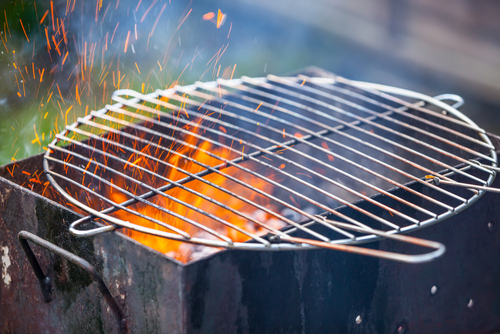Ultimate Barbecue
Barbecuing isn’t just about cooking. It’s about connection, family, smoke, joy, love, and the sacrament of the shared meal. Tending the fire, wearing the apron, roasting the meat and the vegetables, then divvying it all up with one’s clan—it just feels primal.

Possibly it is primal. When our distant cave-dwelling ancestors began scavenging the earth for sustenance—still lacking the means to create fire—all their food had to be eaten raw. These early ape-guys spent up to 12 hours a day gnawing on sinewy flesh and coarse plant matter. They were chewing machines!
Fire changed everything.
Roasted meat and roots were tender. Chewing declined to 45 minutes per day. Think of all the free time!
By some accounts, the brain surged in response to all the nonchewing stimuli humans were suddenly exposed to. In an evolutionary blink of an eye, we went from chewing alone to eating together. This led to dinner conversation, then cave drawing, the pyramids, the Great Wall of China, the printing press, space flight, and the Internet (so we can swap Lolcat photos with our BFFs).
So, why grill? Because it takes us from our harried present back through the generations to that moment when our ancestors sat around the fire, safe and sated, chewing on freshly cooked meat, while all around them the elements raged, volcanoes spewed, and wild things lurked. Is it any wonder that so many of us are passionate about open-fire cooking?
I’m a longtime barbecue guy, having been instructed in the black art by my father, who showed me how to peel loose bits of bark off hickory trees, soak them in water, then lay them on charcoal to produce a thick, blue smoke. It was a simple process, with quick and flavorful results.
Then, on a lark, I signed up for a three-day grilling workshop with Steven Raichlen, author of the classic The Barbecue! Bible and arguably the P. T. Barnum of open-fire cooking. The experience changed everything.
At the course, which took place at the lush Greenbrier resort in Sulphur Springs, West Virginia, we cooked not only chicken, pork, beef, shrimp, and fish but also cabbage, artichokes, corn—even pineapples and plums—searing up five-course meals from start to finish. We learned sauces and rubs. And we cooked on everything from a basic backyard charcoal grill to restaurant-grade gas grills, box-shaped grills, an egg-shaped grill, an infrared grill that cooks at 1,200°F (really!), and multiple variations on the smoker.
I learned that my former practice had been mere grilling. What Raichlen taught was barbecue, which is another thing entirely [see “Setting Up Your Grill”]. And, while the process can get as complex as you want, you don’t have to barbecue fancy to barbecue well. (When the course was all over, Raichlen admitted to me that his favorite dish of all was fresh swordfish, brushed with a bit of olive and seasoned with nothing more than sea salt and freshly ground pepper.)
The point being that open-fire cooking is always satisfying somehow, even when the result isn’t perfect. “It’s more art than science,” says Raichlen, “Every time you make a mistake, what you’ve actually done is come up with a new recipe.”
Watch as Post staffers share their best tips for grilling.
The Best of Barbecue from Emeril Lagasse, Curtis Stone, and Barton Seaver
- Emeril Lagasse’s Greek-Style Lamb Kebabs
- Curtis Stone’s Grilled Shrimp and Asparagus with Lemon-Shallot Vinaigrette
- Barton Seaver’s Grilled Corn with Sweet Pepper Butter
Save and share more of our favorite open-fire recipes by visiting our Grilling Recipe (Smorgas)Board on Pinterest!